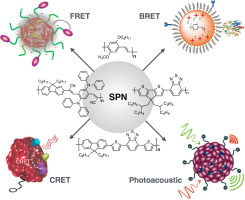当前位置:
X-MOL 学术
›
J. Control. Release
›
论文详情
Our official English website, www.x-mol.net, welcomes your feedback! (Note: you will need to create a separate account there.)
Recent advances of semiconducting polymer nanoparticles in In vivo molecular imaging
Journal of Controlled Release ( IF 10.5 ) Pub Date : 2016-01-08 07:44:57 Kanyi Pu, Niladri Chattopadhyay, Jianghong Rao
Journal of Controlled Release ( IF 10.5 ) Pub Date : 2016-01-08 07:44:57 Kanyi Pu, Niladri Chattopadhyay, Jianghong Rao

|
Semiconducting polymer nanoparticles (SPNs) emerge as attractive molecular imaging nanoagents in living animals because of their excellent optical properties including large absorption coefficients, tunable optical properties and controllable dimensions, high photostability, and the use of organic and biologically inert components without toxic metals. This review summarizes the recent advances of these new organic nanoparticles in in vivo molecular imaging. The in vivo biocompatibility of SPNs is discussed first in details, followed by examples of their applications ranging from sentinel lymph node mapping and tumor imaging to long-term cell tracking, to drug toxicity and bacterial infection imaging for fluorescence, bioluminescence, chemiluminescence and photoacoustic imaging in living animals. The utility of SPNs for designing smart activatable probes for real-time in vivo imaging is also discussed.
中文翻译:

高分子聚合物纳米粒子在体内分子成像中的最新进展
半导体聚合物纳米颗粒(SPN)由于其出色的光学特性(包括大的吸收系数,可调节的光学特性和可控制的尺寸),高的光稳定性以及使用无毒金属的有机和生物惰性成分而成为具有吸引力的分子成像纳米剂,在活体动物中成为有吸引力的分子成像纳米剂。这篇综述总结了这些新的有机纳米颗粒在体内分子成像中的最新进展。首先详细讨论SPN的体内生物相容性,然后举例说明其应用范围,从前哨淋巴结定位和肿瘤成像到长期细胞跟踪,再到用于荧光,生物发光,化学发光和光声成像的药物毒性和细菌感染成像在活的动物中。
更新日期:2016-01-08
中文翻译:

高分子聚合物纳米粒子在体内分子成像中的最新进展
半导体聚合物纳米颗粒(SPN)由于其出色的光学特性(包括大的吸收系数,可调节的光学特性和可控制的尺寸),高的光稳定性以及使用无毒金属的有机和生物惰性成分而成为具有吸引力的分子成像纳米剂,在活体动物中成为有吸引力的分子成像纳米剂。这篇综述总结了这些新的有机纳米颗粒在体内分子成像中的最新进展。首先详细讨论SPN的体内生物相容性,然后举例说明其应用范围,从前哨淋巴结定位和肿瘤成像到长期细胞跟踪,再到用于荧光,生物发光,化学发光和光声成像的药物毒性和细菌感染成像在活的动物中。











































 京公网安备 11010802027423号
京公网安备 11010802027423号